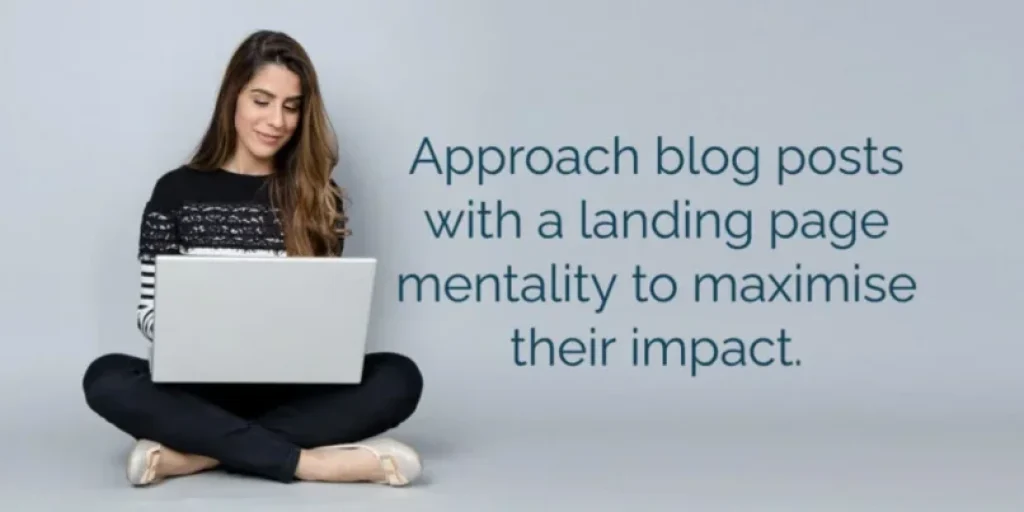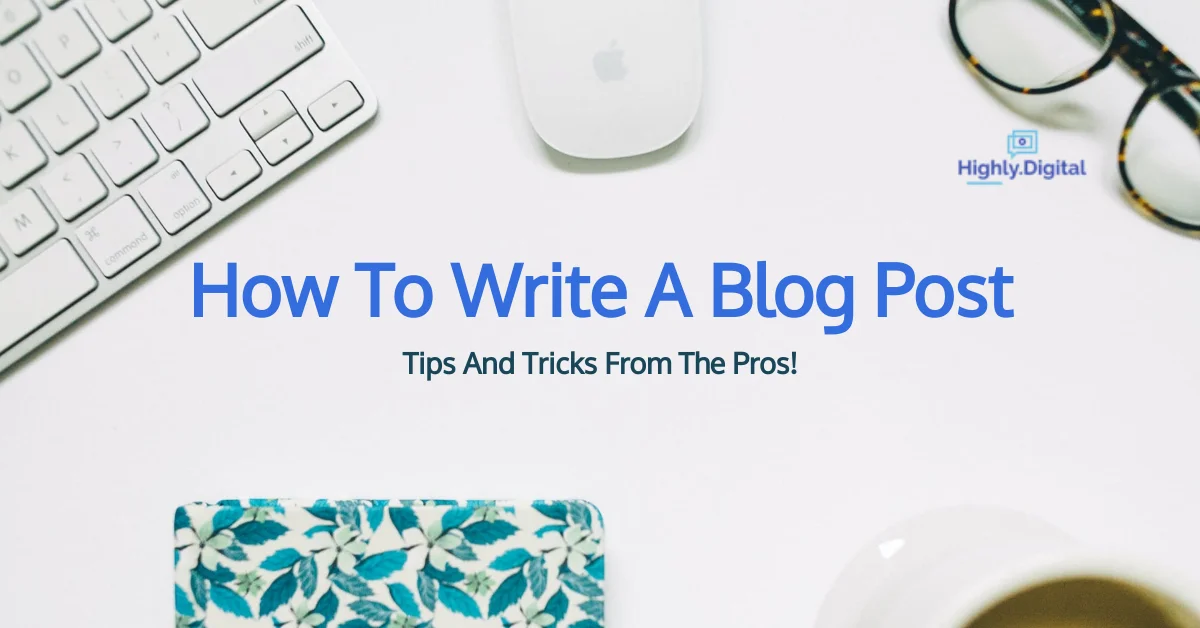By approaching blog posts with a landing page mentality you will maximise their impact. This method will also work for standard content on business websites offering professional services.
What is a landing page?
If you google it, you’ll learn that a landing page is a web page with a single goal in mind. They are usually created to support marketing activities. It’s a single page that you drive traffic towards for a goal-oriented outcome. They are often referred to as lead generation pages.
Landing pages play an important role in your approach to marketing and sales. Marketers are always looking to improve landing pages for a simple reason: money. A high-converting landing page is the holy grail. You spend less and generate more revenue.
However, I am going to provide a different definition of a landing page: “a landing page is the first page your visitor views on your website”. In this context, every page on your website is a landing page.
What does this mean?
The consensus is that landing pages are specific web pages designed with a single goal. Their purpose could be selling a product or service; generating leads; encouraging white paper or eBook downloads, or signing up for a newsletter. Of course, not every page on your website will have these very specific goals, but they should have a goal.
Does your website sell something?
If you have a website for your business, then the answer is almost certainly ‘yes’. You might not be selling directly through your website, but its purpose is to promote your business. Your content (and your ‘landing page’) is there to gently nudge users towards an action that benefits your business.
Transform your blog posts into goal-oriented content
I’m not going to suggest that you turn your blog posts into landing pages. But I am going to suggest that you take a goal-oriented approach to your content.
If you create content that is valuable to your audience and serves a marketing purpose for your business, you are doing content marketing.
Businesses use content marketing to promote themselves. Thus, a blog post must serve a marketing purpose for your business. The art of blogging for business is understanding that you’re not selling, you are informing. You are creating value for your audience.
The purpose of this blog post is to persuade you to learn the benefits of creating goals for your web pages. I’m not actively selling you my services. I’m using this as an opportunity to prove my knowledge, skills and expertise in creating content for a business purpose.
Knowing how to structure a blog post can help in turning them into high-converting landing pages.
Use every web page as an opportunity to convert a reader into a customer.
This doesn’t mean sell, sell, sell. Content marketing should provide value and create a positive user experience. I like to take a content design approach to my blog posts.
What is the purpose of the page?
Define a user need and figure out why the page (or blog post) should exist.
What is your goal?
After someone visits the page, what do you want them to do? Maybe you want them to read another article or maybe you want them to contact you. But you need to define a goal.
Who is your target audience?
Marketing is all about knowing who your audience is, and this should be central to your writing. You should find it easier to write for a persona than for a general audience.
Using conversion-focused copywriting can help turn blog posts into high-converting landing pages.
How do you think people will find the article?
Will you be promoting the article on social media? Or is it more likely that someone will find the page when searching? How good is your SEO?
What are the opportunities for a CTA?
Provide a positive user experience – don’t bombard the reader with too many options.Your goal should be to direct visitors down the desired path, towards your CTA.
How to structure your blog post
Create a visual hierarchy
It’s important to create a visual hierarchy for any web page. Readers tend to quickly scan your blog post to see if it’s what they expected. Make the page scannable using headings and break up the flow of text with imagery.
Consistency
- Be consistent with your fonts and text size.
- Headings should use the same font and be consistent in size.
- All your headings should use the same font.
- Your H2 should be bigger in size than H3.
- The body text should be the same font and size.
- Keep to your brand’s colour palette.
- Your buttons should be the same size and ideally the same colour.
Hero Section

Landing pages will have a big hero section at the top of the page. This will contain an image, a headline and a proposition. However, this approach can be used on other page types. The template for this blog has a big headline followed by an image. The idea is to make a good first impression.
Headline

Make your headline big, strong, and clear so that it stands out from the rest of the text. Buffer suggest a headline should be 6 words and SEO titles should be 55 Characters.
- Use ‘Power Words’ like… Amazing; discover; free; how to; opportunity; secret; or valuable.
- Emphasise the hook in the headline.
- Use numbers e.g. ‘5 reasons…’.
- Invoke fear: ‘beware of these 4 mistakes’.
- Excite your prospect by giving a free sample.
- Provide value in the form of a how-to guide.
- Entice the reader with a question.
H2 subheading
It’s difficult to craft good, short headlines. So use a subheading to reinforce your headline.
Introduction
While it’s tempting to jump straight in, you should write a short introductory paragraph that highlights the benefits you are going to bring the reader.
Copy or main body section
Keep your writing simple and short. Use a tool like Hemingway to improve your writing. Clearly convey what you want visitors to do (i.e sign-up to your newsletter). Highlight the benefits you will give them and what they should expect from you. In the context of a blog post, you want to persuade the reader to do something next. You are offering real value, so you need to capitalise on the opportunity.
Improving your copywriting skills can help in turning blog posts into high-converting landing pages.
Images
You will have heard the expression ‘a picture speaks a thousand words’. Use images sparingly and use them to emphasise your point. While images can (and do) break up text nicely, you don’t want them to be distracting. You can enhance stock photography with visual annotations to strengthen your proposition. Choose images that complement the content.

Clear and contrasted CTAs
Calls to Action (CTAs) are an important part of your page. Make your CTAs stand out by using a contrasting (and consistent) colour. Make sure to include plenty of white space around the CTA. You want to make it easy for the reader to know there’s a CTA.
When writing copy for the CTA highlight the action and benefit. For example: “Get the Report now”.
Crafting effective calls to action is a key step in turning blog posts into high-converting landing pages.
User Journey
Sometimes you won’t want to force a CTA on the reader. There might not be any value in it for you or them. But, you still want them to do something. Remember your goals.
I want you to find value in this article. If you do, hopefully you will read another. While my goal is to get you to sign up for my newsletter, I would be happy if you just read another blog post.
Your page should conclude with a clear path for your readers. I link to relevant blog posts. This is the metaphorical ‘shop window’ to my other content and services. For example: learn how to map the customer journey in 7 steps.
What you should do next
- When promoting your website, please send potential customers to a specific page. Don’t send them to your homepage.
- Use landing pages as inspiration for all your web pages and see if you can generate more leads for your business.
- Start monitoring your analytics. Understanding how your website is being used can generate powerful insights into your marketing activities.
- The next time you create a blog post or an article for your website, think about who it is for and what they would want.
- Try to write a snappy headline. Write several and test these as social media posts. Don’t forget that you can write a longer secondary headline that provides more context.
- Make sure your images are appropriate. Make them into graphics to strengthen your point.
- And finally, don’t forget your goals. Make sure your CTA (or next step) is clear and serves a purpose.
Will this help you?
Do you think you will approach your web pages or blog articles with a different mindset now? Let me know if you enjoyed this article on Twitter or LinkedIn.




